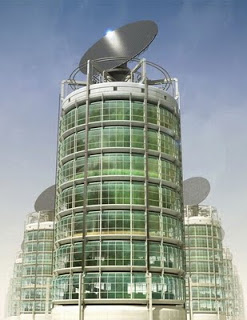As the problems have gained in complexity, so too have the means of overcoming them. More efficient forms of agriculture - fertilisers, irrigation, etc - have been accompanied by breeding and also genetic modification. And now, an even more complex solution: sky farming.
In essence, the idea is to build huge skyscrapers which are enormous vertical farming systems. They address a number of issues: because they are grown vertically, they reduce land use, which could be used for forestry and hence carbon sequestration. They would also mean that the outputs would be produced near to where they are needed, cutting down the need for storage and transportation, with a concomittant reduction in fossil fuels. And they provide a brilliant means of dealing with human sewage, which could be used to generate electricity, fertiliser and water. And most of the technology to do this already exists, and the technology is already being considered in countrues such as Abu Dhabi and South Korea.
Quoting from the article:
“Environmental scientist Dickson Despommier of Columbia University and other scientists propose a radical solution: Transplant farms into city skyscrapers. These towers would use soil-free hydroponic farming to slash demand for energy (they’ll be powered by a process that converts sewage into electricity) while producing more food. Farming skyward would also free up farmland for trees, which would help remove carbon dioxide from the atmosphere. Even better, vertical farms would grow food near where it would be eaten, thus cutting not only the cost but the emissions of transportation. If you include emissions from the oil burned to cultivate and ship crops and livestock in addition to, yes, methane from farm-animal flatulence, agriculture churns out nearly 14 percent of the world’s greenhouse-gas emissions.“You can’t buy vertically grown groceries just yet. Most urban farming efforts have been small-scale experiments run in neighborhood parks. Despommier’s vision is bigger: a $200-million, 30-story tower covering an entire city block, stuffed with enough fruit, vegetables and chickens to feed 50,000 people. “With waste in and food out, a vertical farm would be like a perpetual-motion machine that feeds a lot of people,” he says. Most of the technology already exists, he adds, and with some refining, the project could be up and running quickly if granted 0.25 percent of the subsidies paid to American farmers in the past decade—a piddling $500 million.
“The vertical farm is more than just a produce factory. It’s also a plan to rewire a city’s infrastructure to mimic natural-resource cycles.”
